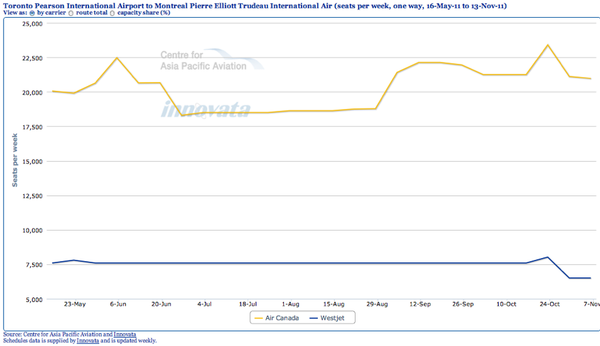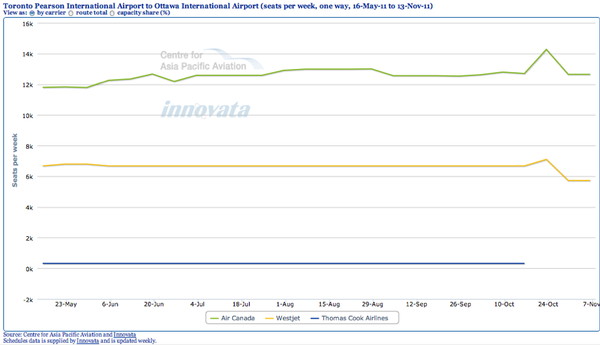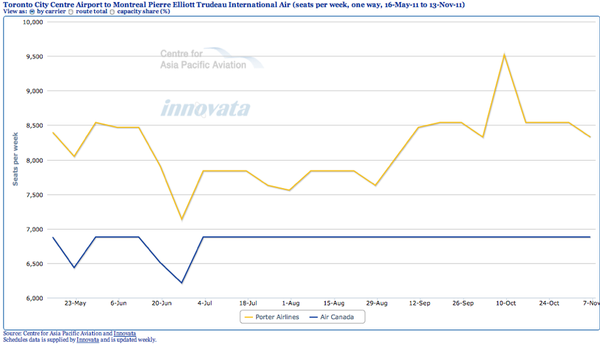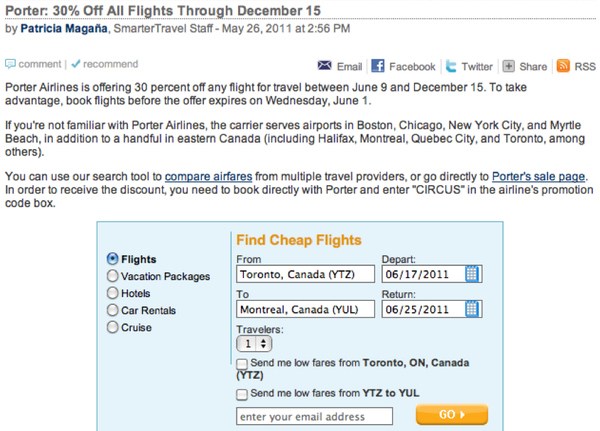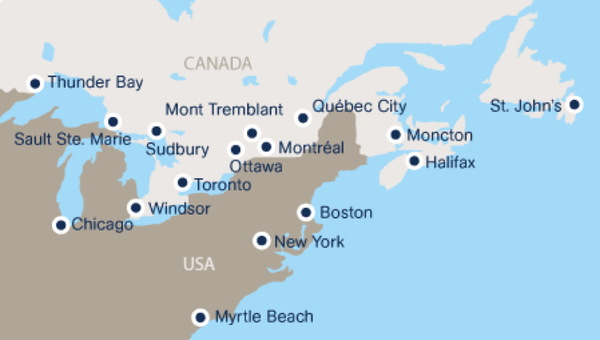Canadian market heating up as LCCs, majors and regional airlines go after one another
There is certainly been no dearth of news coming out of Canada what with the encroachment of WestJet in Air Canada's Eastern Triangle market and the newly launched Billy Bishop Airport service by Air Canada Express Sky Regional inserting competition into the downtown Toronto Airport for the first time.
But the intra-Canadian rivalry is not the only thing worrying Air Canada as suggested by MIT Research Engineer Bill Swelbar who said the Canadian market -- with two-thirds of the country's traffic coming from eight metropolitan markets -- cannot support three carriers. Add on top of that the conflict between Air Canada and its Middle East competitors which has Swelbar laughing because the Canadian carrier is trying to do the same thing with US markets.
Strategic interests overcome capacity discipline
WestJet's expansions in the central Canadian market is a blatant bid for growing its attraction to business flyers and promises to cut into Air Canada's former monopoly there and, given the difference in fares, is likely to be successful.
Read CAPA's Air Canada profile and click through the tabs at the top to do your own analysis of the carrier.
It also comes as Air Canada has finally made it back into Billy Bishop after a five-year hiatus when regional-partner Jazz was summarily ejected in 2006. Air Canada has scheduled 15 daily Toronto-Montreal flights that directly competes with Porter's 19 daily flights in the market. Now that Sky Regional is in the market in the newly branded Air Canada Express, Jazz has no interest at this time into returning to Billy Bishop.
WestJet began service 2-May to the Eastern Triangle market linking Toronto, Montreal and Ottawa with 10 flights daily between Toronto and Montreal and nine flights daily between Toronto and Ottawa. Still, Air Canada's seats in the YYZ-YUL market outnumbers WestJet's three to one and in the Ottawa market Air Canada flies twice the seats that WestJet has scheduled through November, according to CAPA analysis.
YYZ-YUL capacity from Air Canada and WestJet
YYZ-YOW capacity from Air Canada and WestJet
WestJet is kicking in a guarantee offering passengers 50% discount on their next flight if their aircraft is delayed more than 30 minutes. If the flight is ultimately canceled and they cannot travel at a new time, they will receive full credit for the cost of their ticket plus the 50% discount on their next flight in the new markets.
"This initiative is aimed at addressing the needs of our valued business travelers," said WestJet Executive Vice-President, Sales, Marketing and Guest Experience Bob Cummings. "It shows that we take the needs of our business guests seriously, with a strong commitment to on-time performance, conveniences to make their arrival and departure easier, and rewards to recognize and thank them for choosing to fly with us. We believe these offerings are innovative and, when combined with our award-winning guest experience, position WestJet as a compelling choice for business travelers."
See CAPA's WestJet profile and click through the tabs at the top to do your own analysis of the airline.
The problem with all these moves is the amount of capacity being poured into the markets at a time when the airline mantra has become capacity discipline - unless you're crazy - or you have a strategic need to enter such well-served markets. It is clear that moves by both WestJet and Air Canada are strategic.
Air Canada pouring capacity into YTZ-YUL while Porter holds steady
WestJet is not only taking its 737s into the triangle markets but Air Canada has added 15 Q400 trips to Montreal compared to the 19 Q400 trips flown by Porter. That is a lot of lift at Billy Bishop even in a market that carries a fare premium of about CAD30 when comparing current fares with those from Toronto Pearson. Fares range from CAD198-470 one way for Porter's service while Air Canada's new Billy Bishop service ranges from CAD194-460 one way, although the lower fares may be introductory. That seems a pretty good deal when considering all the perks offered to their frequent flyers.
Air Canada's fare between Toronto Pearson and Montreal Trudeau, not flown by Porter, but now flown by WestJet range from CAD163-883 one way while WestJet's new service runs from CAD189-249.
An interesting thing happened last week when Smarter Travel, a meta search engine that aggregates the searches of eight travel sites, picked up Porter's announcement it was taking 30% off all its flights for travel between 9-June and 15-Dec with the offering expiring 1-June. That looks like a pretty good response to the Air Canada move.
What was interesting about it was the fact that Smarter Travel coverage did not link to Porter's website but instead included a link to book flights on the Smarter Travel website. That would be fine, except for one thing. Since Porter is not linked to the GDS world, the only flights coming up in the search are, you guessed it, Air Canada's.
Porter may still have an ace up its sleeve at Billy Bishop
The fight over Billy Bishop has been an interesting one especially given the information revealed by Porter's failed attempt at an IPO last year. Despite the fact it had a monopoly on the route the financials issued as part of the IPO showed the carrier posted EBITDA profitability in every year but its first fiscal year ended 31-Aug-2007, when EBITDA losses were CAD10 million, while net losses were CAD11.4 million. But, since then, it has posted a net loss in the fiscal year ended 31-Aug-2008 of CAD3.3 million and finished its fiscal year to 31-Dec-2009, with a CAD4 million loss. To be fair that was a lousy year for everyone, however.
Read CAPA's profile on Porter and click through the tabs at the top to do your own analysis of the airline.
In an interview with USA Today, CEO Robert Deluce said the airline was now profitable which is a step in the right direction given the fact that Air Canada has its flight information on the global distribution systems and Porter does not. In addition, Porter, Canada's third largest carrier, is now facing the power of the Air Canada frequent flier program which is not insubstantial.
"We are profitable," he told the newspaper. "We have had good solid performance on a year-over-year basis on all of our markets. Certainly our load factors are up, and we're seeing a slightly firmer ticket price than we did a year ago. I think that probably exists right across North America. It's an improving yield scenario, and Porter is benefitting from that as well. And in spite of the higher fuel prices that exist, we're managing very well. Of course, having the Q400 aircraft with its very efficient fuel burn is a big plus in that regard."
In addition, Porter does not have all its eggs in the YYZ-YUL market and now serves 16 destinations with plans for expansion in several top US and close-border markets. On the list for expansion is Washington, DC, New York-LaGuardia and Philadelphia but also Cleveland, Pittsburgh, Detroit and Cincinnati. It now serves Boston, Chicago-Midway and Newark as well as seasonal service to Myrtle Beach in the US. While it would prefer Washington National it is also looking into Baltimore/Washington and Dulles International.
Mr Deluce prefers Washington as its next trans-border destination and it may be able to benefit from the slots Delta and US Airways have offered as part of their latest slot swap deal with one another. They have proposed giving up 16 slot pairs at LaGuardia and eight at National although Porter will be going up against the likes of Southwest and JetBlue to get them. It also sounded as if the new service would not come until it takes delivery of more Q400s later this year and next. He indicated it is likely the airline will exercise the options of four more.
Mr Deluce is being philosophical about his new competition. "We always counted on there being competition," he said. "And it's not as if there hasn't been competition over the last four years. Air Canada has competed strenuously, as has WestJet from Pearson. So, quite frankly, there isn't a lot of difference. The fact that they're here now serving Montreal -- arguably with not as good a schedule as Porter ... and with Porter having at least some indirect involvement in the (Billy Bishop airport) terminal itself sort of helps to keep our position very strong and our offering competitive in every respect. I think at the end of the day passengers will realise that we were instrumental in bringing about the alternative to the existing carrier. And we continue to provide exemplary service, which I think our passengers have responded to well over the past four years … and probably will continue to respond to."
That reference to its position at Billy Bishop is interesting given the fact that it controls the vast majority of slots. In fact, Porter also owns the terminal and Air Canada pays it rent. Porter subsidiary CCTC opened its new CAD49 million terminal at BBTCA in 2010 which is designed to accommodate more than two million passengers annually. The terminal was built to accommodate Porter's long-term growth plans and is part of a vertically integrated infrastructure that, in addition to the terminal, includes operation of four hangers, a corporate flight centre, office space, ramp handling and fuel facilities.
Before it launched service, Porter entered into a sweet commercial carrier operating agreement with the Toronto Port Authority (TPA), giving it virtual control of the airport. Under Porter's agreement with the TPA, the carrier was initially entitled to not less than 95 of the then available 120 slots at BBTCA. Porter was subsequently granted the remaining 25 available slots when they were not used by any other carrier.
Under international slot standards for slot-constrained airports, enshrined in Porter's agreement with the TPA, new entrants are typically allocated up to 50% of new slots, with the balance to incumbents. An independent study showed slot capacity to be 202, now that the new terminal is completed. Porter's agreement with TPA calls for it, as the sole incumbent carrier at the airport coupled with its historical use of slots, to operate 112 of the 202 slots. Under the TPA agreement, Porter is also entitled to be allocated at least 50% of the 90 unallocated slots for a total of 157 with the remaining 45 slots allocated to new entrants. TPA did not return phone calls or emails in the three days run up to publication.
It is now operating 156, Mr Deluce told the newspaper. "There are 16 slots - the equivalent of eight return flights - from Continental that came back into the pool [when Continental turned them back]," he said. "We've obviously expressed an interest in those additional slots. We think we have a reasonable opportunity to capture our fair share of those slots. I think with the approximately 84% of the present slots that are in Porter's hands, we ought to be able to maintain our preferred position at this airport … in much the same way that Southwest has at Midway and that other airlines do elsewhere."
No wonder Porter is so confident but Air Canada has also expressed interest in the Continental slots.
Mr Deluce also does not fear low promotional fares in the market. "We've had to deal with low prices for over four years from time to time," Deluce told USA Today. "We are very capable of matching pricing and we've done that. We offer a full range of pricing. Whether it's WestJet or Air Canada, we continue to be very competitive in the marketplace and we don't see that changing at all. In spite of that, I think the yield generally is still an improvement over what it might have been a year ago. And in our markets - including Montreal - we're certainly carrying more passengers on a year-over-year basis than we were 12 months ago."
Meanwhile, it is touting the fact that its amenities come without extra fees and include extra legroom, complimentary premium snacks, beer and wine.
"[They] really don't cost that much more," Mr Deluce told the newspaper. "It's the small things, the attention to detail, that I think are creating the interest. And the fact that we're more recent; the fact we have now been operating for more than five years. We've seen good growth in all markets - now in 16 different destinations. So it's working."
Porter is already experimenting with focus cities, according to Mr Deluce, who acknowledged that once the 202 slots are all taken, expansion much come elsewhere. "There will be opportunities to extend beyond Ottawa and Montreal and Halifax," he said. "We're doing that right now, in some instances, with Moncton and St John's. And, in due course, there will be an opportunity probably to start linking cities such as Montreal and Ottawa with other destinations - perhaps (on routes) south of the border, such as New York and/or Boston and potentially Washington. So there are lots of opportunities for growth."
He pointed out that non-Toronto routes such as Halifax-St John's and Ottawa-Halifax are experiencing the highest load factors on the Porter system. "The airport [in Toronto] gives us some way of differentiating from Pearson," he said. "But more and more I think it's about service levels and it's the throwback to airlines of prior years, when flying was a bit more fun and when some of the amenities were included. This is what people are recognising Porter for, and, obviously they're finding that attractive. We're being known, more and more, for service and now that we're extending beyond Ottawa and Montreal into other locations, I think that's largely what's distinguishing us from our competitors."
Porter Destinations
When asked about a second Porter hub, Mr Deluce indicated that was already happening at its focus cities as well as Ottawa, Montreal and Halifax. Our first priority will be to maximise the available slots that emerge here at Billy Bishop Toronto City Airport," he added, rejecting a second aircraft type when asked. "But, as this airport caps out in terms of available slots, we'll refocus on the other core cities of Ottawa, Montreal and Halifax."
Air Canada's hub move vs its complaints against Middle Eastern carriers
Air Canada's strategy involves poaching passengers from US markets even as it continues to complain about what it calls unfair competition from Middle Eastern carriers.
CAPA has been covering what CEO Calin Rovinescu calls his International Powerhouse Strategy touting its connections out of Toronto, Montreal and Vancouver to Asia and Europe for at least two years but only now has Air Canada's move gained the attention of the business market with a recent article in the Wall Street Journal.
Perhaps the most interesting angle of this strategy is the fact that Air Canada is doing in the North what Copa Airlines is doing in the South at Panama City, Panama. Copa makes a great case for using the ease of Copa's Hub of the Americas to connect to flights between Asia and Europe and South America. In fact, it is hoping to cut code-share deals with fellow Star Alliance carriers such as ANA and Lufthansa, for instance, to provide one-stop connecting service between Asia, Europe and South America.
Its top argument is the fact that travellers don't have to hassle with getting a visa as they do in the US even if they are only transiting an airport. While some suggest that business travelers are used to getting US visas, others, including US travel industry officials, say that US visa requirements are putting the US at a competitive disadvantage. Consequently, the two carriers are creating a pincer movement against their US competitors.
The Canadian legacy wants to poach traffic at such close-border markets as San Francisco, Seattle, Boston, Pittsburgh and Cleveland citing better weather and the fact they don't have to re-claim their luggage for transiting the Canadian connecting airport as they do in the US. It is also citing less congestion and is now pushing the idea to its corporate clients and travel agents. Interestingly, WSJ quoted passengers who have bought into Air Canada's strategy saying its service is closer to the experience they get on Singapore Airlines, than is the service on US carriers. That is high praise indeed.
Air Canada's global hub strategy is what made Mr Swelbar giggle as he wrote in a recent blog calling Air Canada on its hypocrisy. It is like the US airlines decrying increased airport passenger facility charges even as they pour on their own fees.
Air Canada's has been in a pitched battle with Emirates and Etihad which are using the same strategy to attract Canadian travelers to connect to the world over middle eastern hubs.
There is no question that middle eastern carriers have a competitive advantage over their European and North American counterparts simply because they are not saddled with being the automatic teller machines for their respective governments. The tax burden imposed on European and North American carriers constitutes only one of many competitive disadvantages which also include unions.
Mr Swelbar referenced the trade dispute between Canada and the United Arab Emirates concerning the expansion plans for Emirates, Etihad and Qatar in Canada. He described Air Canada's response as nothing less than protectionism as he quoted Air Canada's CEO Calin Rovinescu in his blog.
"What Emirates wants to do is flood the Canadian market with capacity," said Mr Rovinescu. "Its strategy is to scoop up travelers going elsewhere in the world and funnel them through Dubai, further strengthening Dubai as a global flow hub. [Emirates strategy will] constrain the growth of Canadian airports by turning them from hubs into stubs at the end of a spoke that leads only to Emirates' hub in Dubai."
It was beyond Mr Swelbar not to make the connection between Air Canada's efforts in the giant US market and that of Middle East carriers.
"Its simple, as networks increase in scope, carriers can justify more and more service into secondary and tertiary markets as the connecting possibilities increase exponentially," Mr Swelbar explained. "Rovinescu says he wants to move passengers from one country, through a so-called gateway nation, to a third country. With the exception of Toronto, other Canadian cities would be secondary to Emirates just as Air Canada calls Boston, Pittsburgh and Cleveland secondary."
He suggested Air Canada's attempt to poach traffic as part of its strategy to become a "global juggernaut" as unlikely. "Air Canada was trying to negotiate compensation and work rules with it pilots doing domestic flying versus international flying," he explained. "This points to the simple fact that network carrier legacy rules will not work long-term in either the Canadian or the US market. But, unlike the US, Canada faces a true structural conundrum. Nearly two-thirds of the country's traffic can be found in just eight metropolitan markets. So Air Canada sees the need to raid US markets to fill those big, new airplanes destined for Asia, all along potentially turning US hubs into stubs on the global map."
Mr Swelbar noted the networks of the three Middle East carriers in question were specifically designed to challenge the three global alliances, including Star, in which Air Canada is a member.
"To suggest that there is no inter-alliance competition; one has to look no further than Air Canada's 'international powerhouse' strategy," he said. "What I think is going to be interesting is what to make of the intra-alliance competition for the same traffic and revenue."
He went on to push cross-border ownership, still highly contentious in the US. "Maybe it is also time for US carriers to act and make the rest of the world react," he said. "Air Canada is the poster child for cross-border ownership because the Canadian market cannot support two carriers. And borrowing traffic and revenue from the US is yet another Band Aid solution to problems that underlie the carrier's long-term sustainability. Air Canada certainly knows this to be the truth as well."
Canadian market changing
It is clear that the Canadian market is changing with Air Canada's global hub strategy and its desire to go after Porter and survive WestJet's advances in the business market. It is far from clear how it will turn out. But the events of the last several months in the market point to how the global market is also changing which not only pits legacies such as Air Canada against low-fare rivals and successful point-to-point services such as Porter, but pits all legacies against new entrant behemoths from the middle east.
In addition, the competition is no longer between airlines but between regions as reflected in the moves by Copa, Air Canada and Middle Eastern carriers. The international industry is going through a tectonic shift making it harder and harder for legacies to compete because the level playing field between Europe, North America and Asia has tilted in favor of new entrants from Asia and the Middle East.
Last year, the US Future of Aviation Advisory Committee made recommendations about how government policies need to change if the US wanted to keep its airlines competitive. Nothing has come of that to date but, given the changes in the world market it is clear that traditional assumptions on keeping legacies competitive regardless of whether they are in Canada, Europe or the US, have to be reconsidered such as the tax burden on passengers that put European and North American carriers at such a competitive disadvantage.
Last week, Air Transport Association President Nick Calio pushed its agenda on gaining tax relief noting the tax bite on a ticket has tripled since 1972 from USD22 to USD61 on top of the second highest corporate tax rate in the world at 35%. These airline taxes are tantamount to the sin taxes imposed on gambling, alcohol and tobacco.
"Putting aviation in the 'sin tax' bracket is absurd, given airlines' beneficial - indeed, essential - role," he wrote in an op ed. "Where would we be without airlines? Grounded, as a nation and as a player in the global economy. Aviation levies have been on autopilot, rising steadily and without interruption for years. In the last 10 years alone, collections from US taxes and fees have risen 38%. Taxes stifle the global competitiveness of US airlines, which are so vital to our nation's growth. By making air service more expensive, they lead to fewer business trips, less tourism and higher shipping costs."
It is that type of heresy challenging established practices that need to happen.
